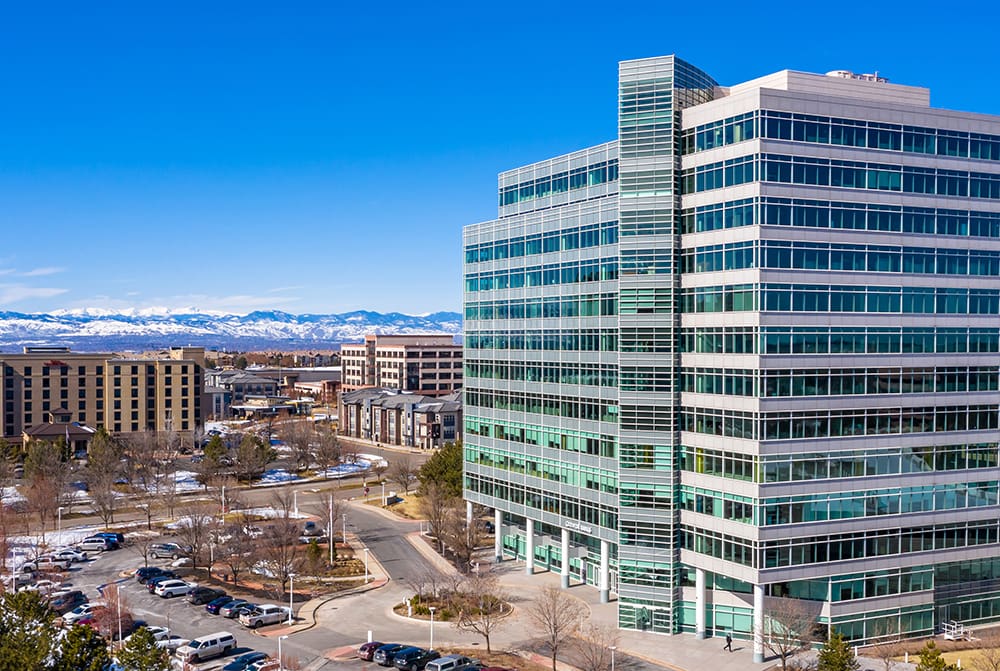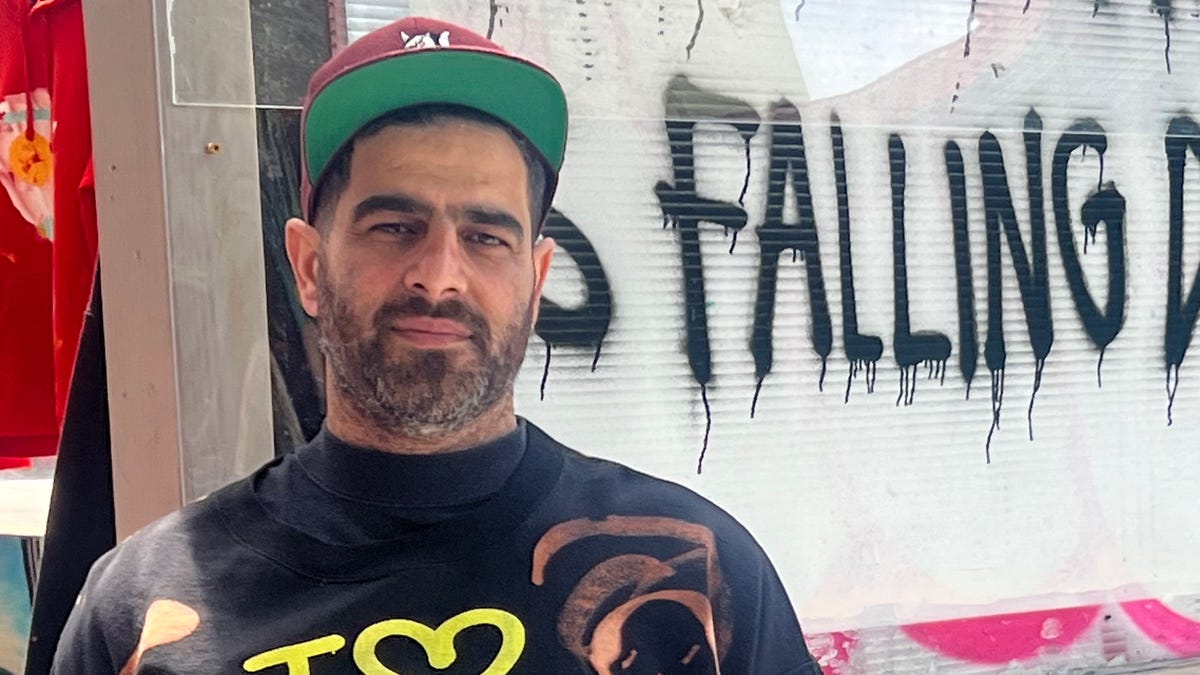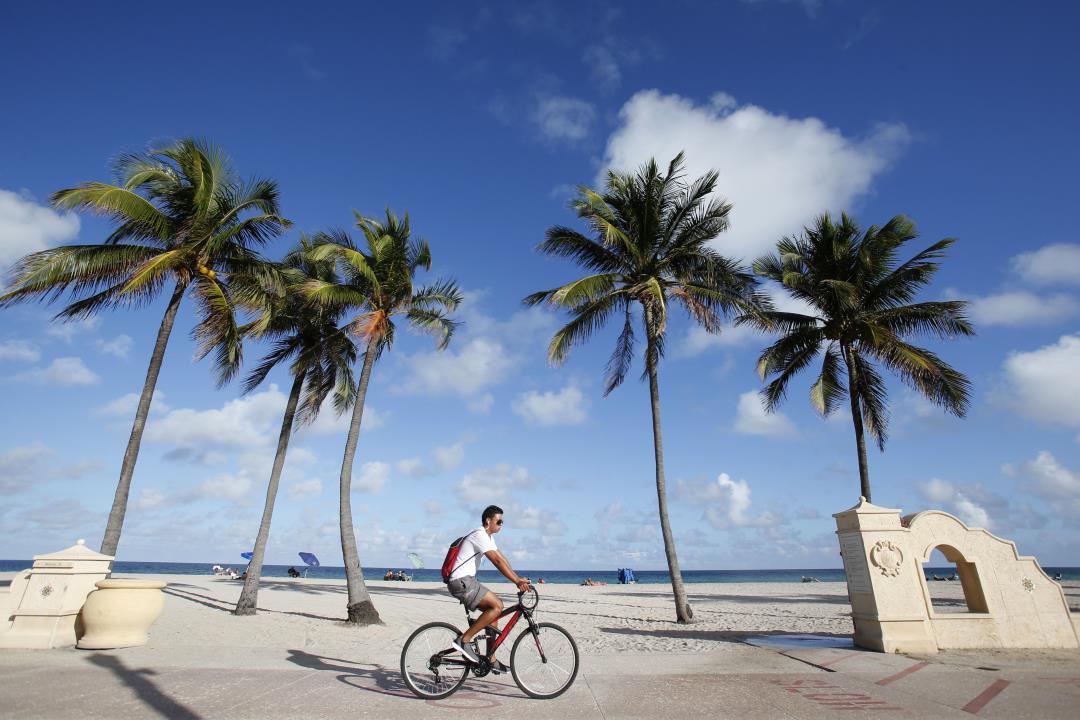Denver, CO
Bike lanes are getting bigger in Denver — and drivers will need to get used to it

At the intersection of the South Marion Street Parkway and Bayaud Avenue, just south of the Denver Country Club, a “ghost bike” spray-painted white stands chained to a shade tree in remembrance of Alexis Bounds, who was killed there while cycling in 2019. A few feet away, a blue street sign asks motorists to drive safely in her memory. Another memorial, faded now after four years, is painted on a nearby sidewalk.
The 37-year-old mother of two small boys was riding in a bike lane on Marion when she was struck by a dump truck. At the time, city planners wanted to improve the safety of the parkway’s bike lanes but were being met by neighborhood opposition.
“What made it horribly poignant is that we were having conversations with the community about the aesthetics, and the function, and the need for this bikeway,” said David Pulsipher, transportation planning manager for the city of Denver. “They were saying, ‘We don’t need it, it’s perfectly safe, I ride it all the time.’ And then that happened.”
There are protected bike lanes on the South Marion Street Parkway now, extending from that crash site south to where the parkway dead-ends at Washington Park. They consist of 4-inch-high concrete barriers separating cyclists from the motor vehicle lanes on both sides of the preexisting median, as well as three-foot flexible white posts that many people complain are unsightly.
“We know from national best practices what actually makes things safer,” Pulsipher said. “And that’s what we are going to pursue, even at the expense of aesthetics or people’s preferences for what the street looks like.”
A mile away, the city is adding control features to another bikeway on Seventh Avenue, from Little Cheesman Park to Grant Street, with intersection modifications and those same flexible white posts, usually called bollards. Some residents have complained about the aesthetics of the mile-long project, while others believe the changes actually will make the street less safe.
Projects like these have proliferated across Denver since 2018 when the city pledged to add 125 miles of bikes lanes in the city. Motorists may grumble when new lanes appear, and homeowners may grouse when they lose parking in their neighborhoods, but city and state officials are determined to encourage more people to leave their cars at home and commute under their own power. They are subsidizing sales of e-bikes, passing cyclist-friendly traffic bills such as last year’s “safe stop” law that made it legal for cyclists in Colorado to treat stop signs as yield signs when there is no oncoming traffic, and adopting “Vision Zero” plans that seek to make streets safer for cyclists and pedestrians with dedicated design improvements that can inconvenience motorists.
Vision Zero is an international campaign that originated in Sweden 30 years ago to eliminate traffic fatalities and severe injuries. It was founded on the principle that, because motorists make mistakes that sometimes cause crashes — advocates prefer not to call them “accidents” — streets should be designed to prevent collisions with cyclists and pedestrians. Dozens of U.S. cities have made Vision Zero commitments including Denver and Boulder. The Denver Regional Council of Governments has signed on as well. DRCOG was one of the first metro planning organizations in the country to adopt a regional Vision Zero plan.
Former Mayor Michael Hancock embraced Vision Zero in his 2017 State of the City address, committing the city to zero traffic fatalities and serious injuries by 2030. In 2018, Denver set its five-year, 125-mile goal, and this past May officials announced they had met and surpassed that goal. Now the total of new bike lanes stands at 145 miles. Some are traditional bike lanes, while others are classified as “buffered” or “protected.”
Common bike lanes run parallel to curbs or parking lanes and are set apart from motor vehicle lanes by striped white lines painted on the pavement. They often include features at intersections that are designed to slow down traffic and make pedestrian crossings shorter.
“Buffered” bike lanes create additional separation from motor vehicle lanes through the use of double stripes of white paint with space in between. “Protected” bike lanes, like the ones on the South Marion Street Parkway, have horizontal and vertical buffers featuring concrete barriers or rubber curbs, along with bollards.
“If we don’t have to be out in traffic, we’re out of the drivers’ way,” said Rob Toftness, co-founder of the Denver Bicycle Lobby, which advocates for cycling safety on city streets. “It’s just better for both parties.”

Denver Councilman Paul Kashmann supports making streets safer for cyclists but concedes the thousands of flexible plastic posts that have sprouted like weeds on Denver streets in recent years are visually problematic.
“I don’t find them particularly aesthetically pleasing, either,” Kashmann said. “That’s one element that I think we need to figure out a better solution.”
Retrofitting city streets in a dense urban environment is a challenge that involves trade-offs that can ignite neighborhood opposition.
“It’s always a challenging discussion when we’re trying to rebuild or fit something into an already built environment,” Kashmann said. “I understand when people get upset because they’ve had parking in front of their house for 20 years, and now that parking is stripped away. I’m not going to minimize that. It is the challenge in squeezing a new use into an infrastructure that’s already at least visibly built out with other uses. We need to make concessions, and we need to hear all voices as we build out these policies.”
On the Seventh Avenue project, traffic circles will be installed this month at six cross streets — Pearl, Emerson, Ogden, Marion, Humboldt and Gilpin — according to Nancy Kuhn, a spokeswoman for Denver’s Department of Transportation and Infrastructure.
But neighborhood resident Natalia Ballinger believes they will make those intersections more dangerous for pedestrians, especially older people.
“This isn’t safety versus aesthetics,” Ballinger said. “We think responsible city planning can be and should be both. You can protect cyclists, and we hope you do everything to protect cyclists, but while not endangering pedestrians and ruining the integrity of the neighborhood.”
But the new North Galapago Street Neighborhood Bikeway between Third Avenue and 13th Avenue is working out great, according to neighborhood resident Lindsay Brown.
“I think it’s fabulous,” Brown said. “I’m not a super cyclist myself, but I’m a runner, so I run through the neighborhood, and I feel like it’s made cars more aware of pedestrian traffic and cyclists. I think the biggest difference is when you’re crossing the crosswalks, (motorists) used to cut the corner when they turned. Now they actually have to turn properly, give it a wider berth. There’s this little bumper zone where, as a pedestrian, you’ve got a little space.”
Other improvement projects have been built recently in the downtown core, including major improvements to Blake Street, which now has a protected bike lane for several blocks.
DRCOG projects the population of metro Denver will grow by another million by 2050, with impacts on traffic congestion and air quality. Its Metro Vision Regional Transportation Plan is designed to promote “a connected and multi-modal transportation system,” said Emily Kleinfelter, DRCOG’s regional Vision Zero planner. That includes bicycle safety projects.
“It is a challenge when you get into some of those dense environments that are a little more residential, where parking can be a challenge,” said Kleinfelter, a cyclist who lives in Capitol Hill, “but that is something that comes with re-prioritizing all modes and understanding that creating protected space for more vulnerable users is something that we have to shift towards doing.”
Sacrificing parking lanes in residential areas to provide safer streets for cyclists and pedestrians is widespread. Sometimes a few parking spots are removed for pedestrian safety at intersections, but when whole parking lanes are lost, that’s usually for design changes intended to enhance the safety of cyclists. Pulsipher estimates there have been more than 30 of those.

“There are trade-offs,” Pulsipher said. “We understand, people have patterns, and it’s very personal. The road that they live on, people take ownership of, and we totally get that. It’s just that there are competing needs for the public right of way, and in some instances, the need for bicyclists’ safety is more important than parking.”
Toftness said residents who complain about lost parking ignore the fact that their street is owned and managed by the city. “When they do these projects, people will talk about, ‘I can’t park in my spot anymore.’ Well, it sounds harsh, but it was never your spot to begin with,” Toftness said. “That’s public space that we reconfigure and make safer for more folks. I’d love for that sentiment to be more widely known.”
Neighborhood bikeways, like the new one on Galapago Street, are usually built on low-volume, low-speed residential streets that prioritize the needs of cyclists, scooter users and pedestrians through the use of signs, pavement markings and traffic-calming features. Traffic lanes are often marked with painted pavement symbols called “sharrows,” depicting a bicycle with two V-shaped arrow marks, which are meant to alert motorists that they must share the travel lane with cyclists because the street doesn’t have a separate bike lane. They also are an aid to cyclists, providing visual continuity through intersections and directing them on a line of travel that keeps them distanced from parked cars where drivers could open doors and endanger them.
Denver transportation planners ultimately want to create a network in which every Denver resident lives within a quarter of a mile of a bikeway where they feel safe and comfortable and to link those bikeways into an interconnected network.
“We need to make them wide enough,” Kashmann said. “We need to make them safe enough. And you need to be able to get from point A to point B. Our bike network, under the Hancock administration, did a good job in moving forward with a whole lot of miles, but we’re still not near connected. And not all of those bike lanes are what I would consider as safe as they need to be, as protective as they need to be.”
The city has set a goal of increasing the number of Denverites who commute to work by bike or on foot from 8% to 15% by 2030.
“We are taking Vision Zero really seriously,” Pulsipher said. “We are trying to do projects that have documented impacts on making it safer for people in their cars, as well as riding their bikes and walking.”
Subscribe to our weekly newsletter, The Adventurist, to get outdoors news sent straight to your inbox.

Denver, CO
Rockies walk 11 Padres but escape with fifth straight victory

SAN DIEGO — The Rockies walked the high-wire Monday night at Petco Park.
Their pitchers teetered and tottered. They walked 11 Padres batters. Count ’em, 11.
But somehow, someway, the Rockies held on to win 5-4, notching their fifth consecutive victory.
The Padres loaded the bases in the ninth against Jalen Beeks on three walks, but Beeks got Manny Machado to ground into a 5-4-3 double play to end the game.
“That was exhilarating, for sure,” a frazzled but happy Rockies manager Bud Black said. “The term ‘hang on tight’ came into play. We had to hang on tight, for sure. But it felt good. The guys in the dugout and the guys on the field erupted. But you don’t draw them up like that.”
No, you don’t.
Monday marked just the third time in franchise history that Colorado walked 11 or more and managed to win the game. In a May 12, 1995 game at Florida, Rockies pitchers walked 12 but beat the Marlins. On June 5, 1999, they walked 12 Brewers at Coors Field but managed a victory.
Black took a risk in the ninth. He visited the mound and instructed the infield to play back, looking for the double play. The strategy paid off.
“We thought there was a double-play chance with Manny, and I thought that was our best chance to win the game,” Black explained. “Even though Beeks is a high-fastball pitcher, he has a chance to get a grounder by choking off a swing with a good fastball, and that’s what he did.”
Perhaps lost in the moras of walks was an outstanding play by veteran right fielder Jake Cave. He raced in on Luis Arraez’s dying line drive and made a diving catch for the first out of the ninth.
“I was just trying to cover as much ground as possible,” Cave said. “Then I saw that I was ‘closing in, closing in,’ so then, I thought, ‘Now I’ve got try for it.’ When I’m healthy, and I’m out on the field, I’m going to go as hard as I can.”
In the final 3 1/3 innings, the Rockies relievers gave up eight walks: three by Beeks, three by Justin Lawrence and two by Jake Bird.
“Bird, Lawrence and Beeks will tell you that’s not good,” Black said.
San Diego crept to within one run, at 5-4, in the seventh on Jackson Merrill’s leadoff homer off Bird. When Bird issued back-to-back walks to Luis Campusano and Ha-Seong Kim, Colorado’s lead appeared to be disintegrating until Justin Lawrence relieved Bird and got Arraez to ground into a 6-4-3 double play. Then Lawrence got the dangerous Fernando Tatis to ground out to third baseman Ryan McMahon.
But the Rockies’ walk-fest continued in the eighth inning when Lawrence walked three to jam the bases but pulled a Houdini escape act when Campusano popped out to center.
Elehuris Montero powered Colorado to an early lead. The first baseman drove in Brenton Doyle with a single up the middle in the second. Doyle reached on a walk, stole second and advanced to third on Cave’s groundout to first.
Montero’s two-run double to left-center off starter Randy Vasquez sparked the Rockies’ four-run fourth. Back-to-back bloop singles by Charlie Blackmon and Ezequiel Tovar drove in the other two runs to put Colorado ahead, 5-1.
Rockies starter Dakota Hudson pitched his best game in a Rockies uniform, got the win and snapped a streak of eight consecutive losing decisions dating back to Sept. 11 of last season when he pitched for St. Louis.
“I felt like we had a good plan going in,” Hudson said. ‘It felt good to get than win.”
The right-hander mowed down the Padres with his bowling ball sinker for 5 2/3 innings until he threw a few gutterballs in the sixth. He issued a two-out walk to Machado and then served up a two-run homer to Jurickson Profar, who crushed his seventh bomb of the season to cut Colorado’s lead to 5-3. The switch-hitting Profar, who played with Colorado last season, hit Hudson’s first-pitch changeup deep into the right-field seats. Profar has already driven in 29 runs.
Hudson, who also mixed in an effective curveball, induced 10 outs via groundballs, struck out three, walked three and gave up just three hits. However, two of the three hits were homers, including Xander Bogaerts’ two-out solo shot in the second.
“I thought the fastball played tonight, and he had a good breaking ball,” Black said. “He threw more curveballs than he had in previous starts, so there was a little more separation of velocity. I thought that was key.”
Want more Rockies news? Sign up for the Rockies Insider to get all our MLB analysis.
Denver, CO
Pro-Palestine encampment set up at DU; protesters make themselves heard at CU Denver, MSU Denver graduations

As the spring semester comes to a close, protests demanding an end to the Israel-Hamas war continue to spread at Colorado colleges, with a new encampment at the University of Denver and disturbances reported at graduation ceremonies last weekend for the University of Colorado Denver and Metropolitan State University of Denver.
A group called DU for Palestine set up a Gaza solidarity encampment at DU’s Carnegie Green on Thursday, mirroring the efforts of the Denver Students for a Democratic Society and Colorado Palestine Coalition, who began an encampment at the Auraria Campus on April 25.
DU administrators shared a new interim policy on protests and demonstrations that day, creating guidelines for acceptable demonstrations and prohibiting those that disrupt meetings or events, impede other DU community members from engaging in free expression, or harm people or property. The policy states the university can relocate and reschedule a protest and perform ticket or identification checks, as well as enforce other safety measures.
“We are focused on maintaining the safety of 12,000 students who are trying to finish out their academic year, while approximately 50 students are trying to make their voices heard,” university officials said in a statement to The Denver Post on Monday. “It’s a balance and one we evaluate and re-evaluate by the hour.”
On Firday, DU for Palestine shared its demands for the school on Instagram, calling for financial divestment from “companies and institutions that profit from or support the illegal Israeli apartheid, genocide and occupation of Palestine,” as well as the severing of all academic ties with “weapons manufacturers” and Israeli universities, according to the post.
On Saturday, DU for Palestine alleged the university’s administration planned to sweep the encampment and had requested that encampment participants present DU student identification, according to another Instagram post. DU officials denied it had threatened to “sweep” the camp or have anyone arrested.
“We have seen various instances of noncompliance from encampment participants, including refusal to show university-issued ID upon request.” DU stated in a Sunday news release, reminding students that noncompliance could result in a referral to the Student Rights and Responsibilities or the Office of Equal Opportunity and Title IX.
The Post could not reach protest organizers for comment Monday.
DU for Palestine met with the university’s administration for the first time on Friday and again on Sunday, according to a DU news release.
“We went into that meeting really wanting to talk about disclosure. That’s really the first step to all of our demands is disclosing what investments the University of Denver has with the state of Israel and companies that operate within the state of Israel,” Jojo Carranza, a DU graduate student and DU for Palestine member, said during a news conference on Sunday. “In that meeting, our demands were not met to disclose those investments. What was given was a verbal agreement that they would continue meeting with DU for Palestine on topics of disclosure.”
The protests at DU follow on the heels of the Gaza solidarity encampment at Tivoli Quad on the Auraria Campus, where students are calling for the UC system and MSU Denver to divest from all funding and activities related to Israel. Police arrested more than 40 students and dismantled the camp on April 26, with officials citing the campus’s policy against camping. The encampment, now 18 days old, was rebuilt later that day.
Anti-war protesters also disrupted CU Denver’s commencement ceremony at the Denver Coliseum on Saturday by yelling and chanting, according to reporting by Denver 7. Demonstrators also interrupted the MSU graduation ceremony with chants of “free Palestine,” accompanied by raised hands dipped in red paint, according to a post by SDS Denver.
Demonstrations at other Colorado universities at the beginning of May, including the University of Colorado Boulder, Colorado State University, University of Northern Colorado and Colorado College, called for a ceasefire and for campus leaders to divest from activities and funding related to Israel.
Get more Colorado news by signing up for our daily Your Morning Dozen email newsletter.
Denver, CO
Land Advisors Organization Establishes Presence in Denver – Mile High CRE

Land Advisors Organization, the nation’s largest brokerage focused specifically on land, has expanded into the Denver market to serve landowners, home builders and developers. The firm’s newest office, located on the 9th floor at 4600 South Syracuse Street in Denver, is led by Tom Kaufman, a real estate veteran with expertise in raw land, land planning, land management, subdivision management, and land brokerage.
Kaufman, who previously worked with Land Advisors Organization over a decade ago, focuses on advising landowners and purchasers of land parcels throughout the Denver metro area and across the Front Range. He has extensive experience working with parties on the sale and purchase of vacant land parcels and large-scale developments. He provides valuable insight into site selection, real estate planning and the various issues faced by the homebuilding industry, developers and investors in the market.
“The Denver market’s consistent growth and our relationships with many builders looking to expand their presence there are behind our decision to re-establish our presence in Colorado,” said Greg Vogel, CEO of Land Advisors Organization. “Tom’s background and knowledge of the market set him apart, making him an exceptional advisor to landowners and developers, and allows us to provide significant opportunities to both local and national builders, and developers expanding in the region.”
Active in the commercial real estate and homebuilding industries, Kaufman is involved with the Homebuilders Association (HBA) of metro Denver, serving on the HBA’s Metro Housing Coalition committee. Additionally, he is involved with the Urban Land Institute (ULI), serving on ULI’s Growth Outreach Committee. He is also a member of the International Council of Shopping Centers (ICSC), and the National Association of Industrial and Office Parks (NAIOP). In the community, Kaufman dedicates his free time to several causes that benefit children, veterans and pets.
Kaufman earned both a bachelor’s degree in human resource management and a Master of Business Administration in Management Information Systems from Northern Arizona University in Flagstaff, Arizona.
Completed in 1999 and renovated in 2013, 4600 S. Syracuse offers desirable features such as floor-to-ceiling windows offering panoramic mountain and downtown views, efficient 25,000-square-foot floorplates and recently updated conferencing and fitness facilities. The 13-story building also features a 727-space parking garage and additional development upside through excess land that could potentially host an office tower or multifamily development.
-

 Politics1 week ago
Politics1 week agoAustralian lawmakers send letter urging Biden to drop case against Julian Assange on World Press Freedom Day
-

 World1 week ago
World1 week agoBrussels, my love? Champage cracked open to celebrate the Big Bang
-
News1 week ago
A group of Republicans has united to defend the legitimacy of US elections and those who run them
-

 Politics1 week ago
Politics1 week agoHouse Dems seeking re-election seemingly reverse course, call on Biden to 'bring order to the southern border'
-

 World1 week ago
World1 week ago‘It’s going to be worse’: Brazil braces for more pain amid record flooding
-

 Politics1 week ago
Politics1 week ago'Stop the invasion': Migrant flights in battleground state ignite bipartisan backlash from lawmakers
-

 World1 week ago
World1 week agoGerman socialist candidate attacked before EU elections
-

 World1 week ago
World1 week agoSpain and Argentina trade jibes in row before visit by President Milei




















